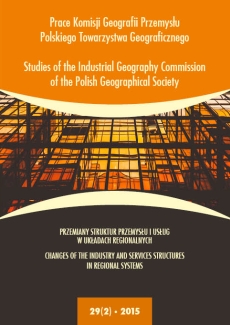Depression of the Cities: Key to Healing
DOI:
https://doi.org/10.24917/20801653.292.11Keywords:
cultural geography, depression, social psychology, treatmentAbstract
The problem of search of an authenticity of the cities looks very actual and draws attention of numerous researchers. In the article the analogy between the human person and the city in this problem is used. For the person, as well as for the city, awareness of own identity is necessary to resist depressive tendencies. It is shown that symptoms of depression of the person are similar to the ones for depression of the cities. The identity of the city necessary for opposition of a depression is offered to be looked for in two planes - historical and geographical (to be looked for in historical and geographical plane). The historical plane is made by local myths and legends of the city and its inhabitants. The geographical plane of identity is concentrated on features of relief, climate, flora and fauna of that region in which the city is located.
Downloads
Metrics
References
American Psychiatric Association (1994). Diagnostic and Statistical Manual of Mental Disorders. (4th ed.) (DSM-IV). Washington, DC: APA.
Bell, D.A., de-Shalit, A. (2011). The Spirit of Cities. Why Identity of a City Matters in a Global Age. Oxford: Princeton University Press.
Bykow, J.W. (2009). Rezistentnyje k terapii depresji. Stawropol: Idea+.
Casakin, H., de Fátima Campos Bernardo, M. (Eds) (2012). The Role of Place Identity in the Perception,
Understanding, and Design of Built Environments. London: Bentham Science Publishers. Detroit Tops 2013 List Of America’s Most Miserable Cities Forbes (2013, 21 February). Retrieved from http://www.forbes.com/sites/kurtbadenhausen/2013/02/21/detroit-tops-2013-list-of-americas-most-miserable-cities/.
Dugarowa, G.B. (2003). Depresywnyje terytorii: wozmożnyje puti ozdorowlenia. EKO, 89–97.
Frankl, V.E. (2004). On the Theory and Therapy of Mental Disorders. An Introduction to Logotherapy and Existential Analysis. London–New York: Brunner–Routledge.
International Statistical Classification of Diseases and Related Health Problems 10th Revision (ICD-10) Version for 2010. Retrieved from http://apps.who.int/classifications/icd10/browse/2010/en#/V. Jago, C. (2013). The Challenges for Antidepressant Medicines. Retrieved from http://lsconnect.thomsonreuters.com/challenges-antidepressant-medications/.
Jung, C.G. (1991). Aion – Researches Into the Phenomenology of the Self. In: Collected Works of C.G. Jung. London: Routledge.
Kaymaz, I. (2013). Urban Landscapes and Identity. In: Advances in Landscape Architecture. MuratÖzyavuz (Ed.). Chapter 29. Istanbul: InTech, July 7, 31–47.
Längle, A. (2000). Depression. In: Stumm G., Pritz A. (Hg) Wörterbuch der Psychotherapie. Wien:Springer.
Lengle, A. (2010). Dotjanutsia do żyzni. Ekzistencialnyj analiz depresji. M. Genezis.
Lidin, K.L. (2011). Gorod-pocient. K isledowanijam emocionalnoj atmosfery gorodow. Projekt Bajkal,29–30, 33–36.
Lidin, K.L., Meerowicz, M.G. (2006). Predczuwstwije policentricznosti. O „nesowetskom” projektie irkutskich arhitektorow 1970-h. Projekt Bajkal, 9, 20–23.
Liubbe, G. (1994). Istoriczeskaja identicznost. Woprosy folosofii, 4, 108–113.
Meneghetti, A. (2011). Project Human Being. Roma: Ontopsicologia Editrice.Murray, C. J.L., Lopez, A.D. (Eds.) (1996). The global burden of disease. A comprehensive assessment of mortality and disability from diseases, injuries, and risk factors in 1990 and projected to 2020. Cambridge, MA: Harvard School of Public Health.
Musijezdow, A.A. (2013). Teritorialnaja indenticznost’ w sowremennom obszczestwie. Labirint.Żurnal socialno-humanitarnych isledowanij, 5, 51–59.
Owczinnikowa, N.P. (1990). Rossija na Wsemirnoj wystawke 1900 goda w Parże. Żyliszcznoje stroitelstwo, 7, 27–29.
Proshansky, H.M., Fabian, A.K., Karminoff, R. (1983). Place identity: Physical world socialization of the self. Journal of Environmental Psychology, 3, 57–84.
Rahim, H. (2013). Identity and sense of place in the new cities. In: Proceedings of the InternationsalSymposium “Urban Mobility and Integrated Transportation”. Retrieved from http://future-megacities.org/fileadmin/documents/Proceedings-MCMob-El-Gouna-2013-05-09.pdf.
Russell, J.M., Hawkins, K., Ozminkowski, R.J. et al. (2004). The cost consequences of treatment-resistant depression. Journal of Clinical Psychiatry, 65(3), 341–347.Sarvepalli, R. (1923). Indian Philosophy. Vol 2. London: Oxford University Press, 807.
Sogomonow, A. (2010). Sowremennyj gorod: strategija identicznosti. Neprikosnowennyj zapas, 2(70),67–73.
Ukolowa, M.A. (2005). Metodiczeskije podchody k opredeleniu stepeni depresiwnosti gorodskich teritorij. Disertacja na soiskanije uczonoj stepeni kandidata ekonomiczeskich nauk. Ikkutsk: BGUEP, 20.
Weissman, M.M., Bland, R.C., Canino, G.J., Faravelli, C., Greenwald, S., Hwu, H-G. et al. (1996).Cross-national epidemiology of major depression and bipolar disorder. JAMA: Journal of the American Medical Association, 276, 293–299.
World Health Organization (2005). (2010, 6 March). Depression. Retrieved from http://www.who.int/ mental_health/management/depression/definition/en/.
Yi-Fu, T. (1977). Space and Place: The Perspective of Experience. Minneapolis, MN: University ofMinnesota Press.
Zetter, R., Butina, G. (Eds) (2008). Designing Sustainable Cities. Watson: ASHGATE.
Zukin, S. (2010). Naked City: The Death and Life of Authentic Urban Places. New York: OxfordUniversity Press.
Downloads
Published
How to Cite
Issue
Section
License
Articles are published under the terms of the Creative Commons License (CC BY-ND 4.0; Attribution– NoDerivs).

